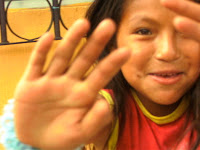 Enmanuel, a native of Guatemala, lives in San Antonio Aguas Calientes with his mother. After opening a paper store for the students in the area, Enmanuel has plans to develop a multi-sports field and playground on land he already owns. His vision is to provide a free and safe space for the children in the community to play. Alongside the volleyball/soccer/basketball field, he would like to build a playground and concession stand. In the spirit of his father, Enmanuel hopes to become an active leader in the community by supporting the healthy development of the children of San Antonio Aguas Calientes.
Enmanuel, a native of Guatemala, lives in San Antonio Aguas Calientes with his mother. After opening a paper store for the students in the area, Enmanuel has plans to develop a multi-sports field and playground on land he already owns. His vision is to provide a free and safe space for the children in the community to play. Alongside the volleyball/soccer/basketball field, he would like to build a playground and concession stand. In the spirit of his father, Enmanuel hopes to become an active leader in the community by supporting the healthy development of the children of San Antonio Aguas Calientes.Escuela de Katchiquel
 Olga, a true entrepreneur at heart and in practice, owns and operates her own bakery, is helping her son to open a laundry mat, and, on occasion, hosts Peace Corp volunteers in her home. Professionally, she works as a Spanish teacher at a school in Antigua. Olga has hopes to transfer her skills as a teacher into opening her own school in San Antonio Aguas Calientes. Her mission: to teach Katchiquel (a Mayan language) to preserve and share her Mayan heritage. Olga's school will be the first of its kind in San Antonio, and she is working to attract not only tourists interested in learning Katchiquel, but also the youth in the community, as knowledge and use of the language is diminishing.
Olga, a true entrepreneur at heart and in practice, owns and operates her own bakery, is helping her son to open a laundry mat, and, on occasion, hosts Peace Corp volunteers in her home. Professionally, she works as a Spanish teacher at a school in Antigua. Olga has hopes to transfer her skills as a teacher into opening her own school in San Antonio Aguas Calientes. Her mission: to teach Katchiquel (a Mayan language) to preserve and share her Mayan heritage. Olga's school will be the first of its kind in San Antonio, and she is working to attract not only tourists interested in learning Katchiquel, but also the youth in the community, as knowledge and use of the language is diminishing.Irla, a driven and uniquely talented weaver, supports her family’s artisan business through her San Antonio market stall. As a highly zealous and bright mother of two, she sought to develop a brand and marketing initiative promoting her family’s exceptional crafts, as well as offer an array of distinct Mayan activities to the culture-hungry traveler. Recently, Irla had the memorable experience of hosting a foreign student in her home, and looks forward to the opportunity to share her family’s traditions with more interested travelers. Natural herbal medicines derived from the family’s garden, the language of Katchiquel taught by Irma’s father, and lessons in the preparation of naturally pigmented thread made from their cotton tree are just some of the many unique Mayan activities Irma and her family offer. After naming her business IXEL K’IEM (a nod to the Katchiquel god of weaving), and with the support of business cards, a comprehensive brochure in both Spanish and English, and an email address, Irma and her family hope to gain the publicity their remarkable business warrants.






























